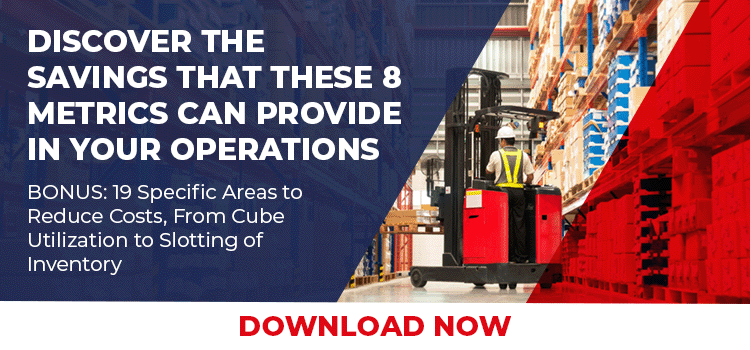Inventory management is a strategic issue that affects profitability and customer service. Additionally, many fulfillment centers are overstocked with slow-selling merchandise tying up valuable inventory locations. While an item’s inventory cost is the majority of the expense, it is only part of the costs incurred when you consider credit borrowing. labor and facility expenses to maintain and store inventory, plus lost opportunity costs should be considered when thinking about where to use cash elsewhere in the business.
In working with clients to evaluate warehouse space use, one client’s additional costs were 11.25% over and above the cost of inventory. In states with inventory taxes or higher labor and facility expenses additional costs can be 25%.
Identifying Potential Overstock
 Overstocks can be an emotional issue with merchants so identifying objectively the overstock level is the first step. Here is an example. In an operational assessment of warehouse space use for a book publishing client, we analyzed every item’s selling at the SKU level compared to the on-hand inventory. A simple formula: item on-hand quantity divided by total sales over a time horizon. If you use sales for a typical month divided into the on-hand, then this shows the number of months of stock.
Overstocks can be an emotional issue with merchants so identifying objectively the overstock level is the first step. Here is an example. In an operational assessment of warehouse space use for a book publishing client, we analyzed every item’s selling at the SKU level compared to the on-hand inventory. A simple formula: item on-hand quantity divided by total sales over a time horizon. If you use sales for a typical month divided into the on-hand, then this shows the number of months of stock.
While extreme, for this client, 60,000 SF of the total 360,000 SF warehouse was holding slow selling product. The overstock could be measured literally in years of sales by item. In this case large book sellers have negotiated return privileges. Given thousands of new titles annually, liquidating this type of over stock is doubly difficult because the product has high unit cost.
Have you performed an analysis of your potential overstock?
Liquidation Strategy Guidelines
Here are seven guidelines to consider as you develop your inventory and liquidation strategies:
1. Make improving inventory performance a strategic initiative.
In most companies, inventory is the largest balance sheet asset. Here are 23 Ways to Improve Inventory Management. Developing a comprehensive inventory strategy involves a number of departments — including fulfillment, marketing, and merchandising, inventory control and purchasing.
2. Recognize Pareto’s Law.
Reducing overstocks can be an emotional issue with merchandisers and purchasing departments because it implies “failure”. It truly should not be - it has been shown that 20% to 25% of the SKUs give you 70% to 80% of the sales in most businesses. Markdowns and slow-moving inventory are a fact of life. It’s important to continually address slow moving product to free up cash and fulfillment center space.
3. Exception reporting of slow movers.
Does your inventory analyses identify candidates for liquidation in the total assortment based on rate of sale and stock on-hand (illustrated above)?
4. Identify media and rate of sale by price point.
There are 12 media or methods discussed in Methods to reduce overstocks below to liquidate overstocks. Not all are appropriate for every business. Which are appropriate for your business in terms of the quantity of overstock and yield the highest recovery of cost (see Recovery of product cost below)?
5. Make your first price cut the deepest.
Customers are savvy to whether they are getting a real deal. As illustrated above, what additional costs are incurred monthly. Holding low margin product can become costly. Additionally, many consumer products have a short life cycle and you don’t want to be left with large remainder quantities by waiting for them to sell at full price.
6. Assign responsibility.
In your organization, who analyzes and decides on inventory to be liquidated? Companies with large assortments sometimes put a single person in charge- separate from the buyer - to move the slow selling product through various media and lowering prices. Also, make key inventory metrics and goals part of the buyer/merchant performance review including markup, back orders rate, gross margin and inventory turnover.
7. Synchronize promotions and purchase order placement.
Do you have a merchandising and marketing calendar of what product will be offered forward in your business? This often helps buyers understand the purchase order requirements over multiple offers. It reduces back orders and overstocks.
All of these are critical to managing inventory as a strategic objective.
Methods to reduce overstocks
Relist or rephotograph slow sellers. Use this if prior copy and photo did not show the product well. But a great photo and copy isn’t going to sell a below average selling product;
- Develop Call Center programs – by program we mean how to inform and sell the customer using inbound and outbound calling scripts to move product;
- Package inserts and flyers – include in every outbound package and refresh with new products regularly. Customers receiving your shipment today should be the most satisfied and open to an additional sale;
- Special website offers – make clearance specials easily identifiable or pop up;
- Email blasts - given the low cost of this medium, use this to feature items with large quantities to liquidate;
- On-line marketplaces – investigate use of eBay, Etsy and Amazon and their applicability;
- Warehouse and tent sales – can move major overstocks as well as small remainder quantities of consumer products. Scheduled semi-annual event. It takes preparation and advertising;
- Barter agreements – can move large quantities but it has to be product that has value to both partners;
- Employee sales – these can be part of the benefits offered on a regular basis or as a semi-annual event;
- In-kind donations -– give product to charities, schools and churches that can use it or resell the product. Tax deduction under Section 170 (e)(3) of the U.S. Internal Revenue Code;
- Return to vendor – usually has to be pre-negotiated as part of purchase order. There may also be a restocking fee;
- Liquidation companies and jobbers – they can move large quantities but may only give $0.10 on a $1.00 of cost;
All of these may not be appropriate for your company based on the product, quantity to be liquidated and the age of the inventory.
Recovery of Product Cost
It’s important to collect how many units are sold, at the specific selling price and by media. This will give you valuable information for future liquidation offers and item pricing. Depending on the inventory system, that may not be as easy as it sounds. Many times, inventory systems can only have a single retail price. They may not be able to collect and report the number of units sold by retail selling prices. Some systems only track full price product not price reduced priced sales. When product is marked down or not in a full retail status, all trackability may be lost. What are your systems capabilities?
Here are a few liquidation methods and their potential cost recovery:- Return to vendor – usually has to be pre-negotiated as part of purchase order. You may get 100% of the cost recovered or maybe there is a restocking fee pre-negotiated (e.g. 15%);
- Employee sale - can range from 10% to 33% off retail price when offered to customers at full price. This method gives 100% cost recovery and hopefully a profit.
- Liquidation companies and jobbers - may only give $0.10 on a $1.00 of product cost;
All media and methods need to be tracked to determine which gives the highest cost recovery.
Keeping inventory lean is a great improvement to company profitability and freeing up warehouse space. This is one critical aspect to you inventory initiative.







SHARE